使用原型自定义需求和链接
您可以使用原型来定义自定义需求或具有自定义属性的链接类型。您可以使用原型将属性应用于需求需求集子集或链接。要定义一个原型,请创建一个配置文件来包含该原型,将配置文件分配给需求集或链接集,然后将原型与需求或链接一起使用。您可以通过将配置文件分配给多个需求集或链接集来重用原型。
您可以使用 sl_customization 文件和自定义属性创建自定义需求和链接类型和属性。有关详细信息,请参阅定义自定义需求和链接类型和属性。
创建配置文件并定义原型
原型定义特定领域的元数据。配置文件是一组原型。在 Requirements Toolbox™ 中,您可以使用原型来定义自定义需求,或者通过使用配置文件编辑器来定义具有自定义属性的链接类型。
创建配置文件
在定义原型之前,您必须创建一个配置文件。
通过在 MATLAB® 命令行中输入此命令来打开需求编辑器:
slreq.editor
在配置文件部分中,点击配置文件编辑器
 。
。在配置文件编辑器中,点击新配置文件。选择新的配置文件。
在右侧窗格中,命名配置文件并添加描述。点击保存。
编辑器将配置文件保存为 XML 文件。
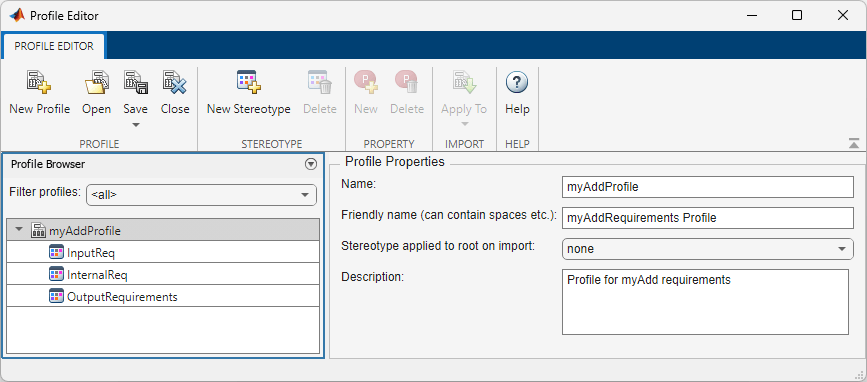
定义原型
定义一个原型:
在配置文件编辑器中,选择包含原型的配置文件,然后点击新原型。选择新的原型。
在右侧窗格中,输入原型的名称和描述。
将应用于设置为需求或链接。
将基本行为设置为内置需求类型或链接类型之一。
基本行为影响需求或链接如何有助于实现和验证状态。需求和链接原型从内置需求和链接类型继承功能,方式与自定义需求和链接类型相同。有关详细信息,请参阅选择内置类型作为基本行为。

如果您正在为链接创建原型,请使用前向名称和后向名称属性设置原型的前向和后向名称。
需求编辑器使用前向名称和后向名称来描述两个链接项之间的关系。例如,如果您创建一个名为
Satisfy的原型,您可以选择前向名称Satisfies和后向名称Satisfied by。有关更多信息,请参阅链接类型中的表格。
提示
要从另一个原型继承属性,请将基本原型设置为来自打开的配置文件的原型。基本原型和子原型都必须将应用于设置为相同的值。然而,基本原型和子原型可以具有不同的基本行为值。
您只能使用抽象原型作为基本原型,而不能将其直接应用于需求或链接。要创建抽象原型,请选择抽象原型。
向原型添加属性
您可以向原型添加属性来提供有关需求和链接的附加信息。原型属性仅适用于您应用原型的需求或链接。此行为不同于自定义属性,自定义属性适用于需求集或链接集中的所有需求或链接。有关详细信息,请参阅定义自定义需求和链接类型和属性。
要向原型添加属性,请在配置文件编辑器中选择一个原型,然后点击添加新属性按钮  。输入属性的名称并选择类型。对于数值类型,您可以设置单位。
。输入属性的名称并选择类型。对于数值类型,您可以设置单位。
要使用枚举作为原型属性的类型,请将类型设置为枚举。在枚举定义对话框中输入现有枚举类的名称,然后点击确定。如果不存在枚举类,您可以输入新枚举类的名称,然后点击确定来创建一个。在未找到枚举类对话框中,点击创建从模板创建枚举类文件。编辑类文件以包含您想要的枚举。有关详细信息,请参阅定义枚举类。
分配配置文件并使用原型
要使用具有需求和链接的原型,请将配置文件分配给需求集或链接集:
或者,您也可以通过对 slreq.ReqSet 使用 importProfile 函数或对 slreq.LinkSet 使用 importProfile 函数以编程方式分配配置文件。
要使用具有需求或链接的原型,请在需求编辑器中选择需求或链接。在右侧窗格中,在属性下,将类型设置为原型。
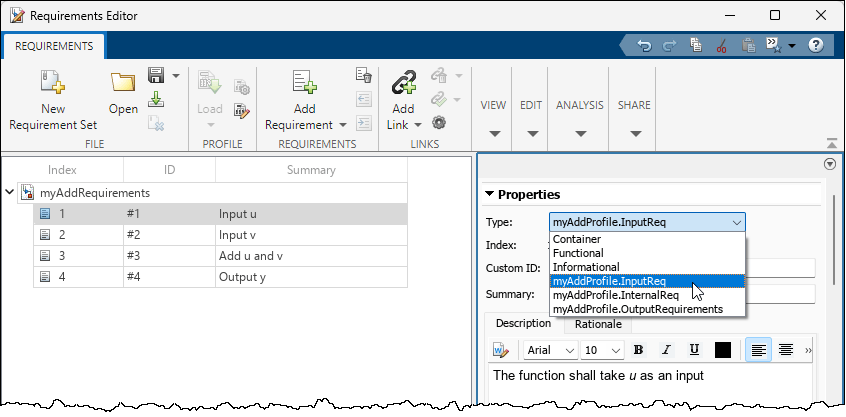
或者,您可以以编程方式设置需求的 Type 属性或链接到原型的完全限定名称。例如:
myReq.Type = "myProfile.ReqStereotype";设置原型属性值
要设置原型属性值,请在需求编辑器中选择需求或链接。在右侧窗格中的原型属性下,设置值。

要以编程方式设置原型属性值,请使用 slreq.Requirement 的 setAttribute 方法或 slreq.Link 的 setAttribute 方法。要以编程方式查看原型属性值,请使用 slreq.Requirement 的 getAttribute 方法或 slreq.Link 的 getAttribute 方法。
编辑配置文件和原型
在编辑配置文件或原型之前,请关闭该配置文件所分配到的需求集和链接集。在需求编辑器中,选择需求集或链接集,然后点击关闭。或者,您可以使用 close 或 slreq.clear。
要编辑配置文件或原型,请打开配置文件编辑器。点击打开打开配置文件。您可以编辑配置文件及其原型的属性,包括名称、描述、基本行为、基本原型和原型属性。
修复过时的配置文件
如果您对配置文件进行更改,然后加载使用该配置文件的需求集或链接集,则 Requirements Toolbox 表示分配给该需求集或链接集的配置文件已过时。
如果您加载具有过时配置文件的需求集,则会出现“过时配置文件”对话框。您可以通过展开详细信息部分来查看自上次加载需求集以来对配置文件所做的更改。要将更改应用到需求集,点击删除在配置文件中找不到的所有原型和属性,并同步所有更改旁边的修复。如果您不想将更改应用到您的需求集,您可以通过点击关闭需求集,并确保所有配置文件都可以在 MATLAB 搜索路径中找到旁边的修复来关闭该需求集。
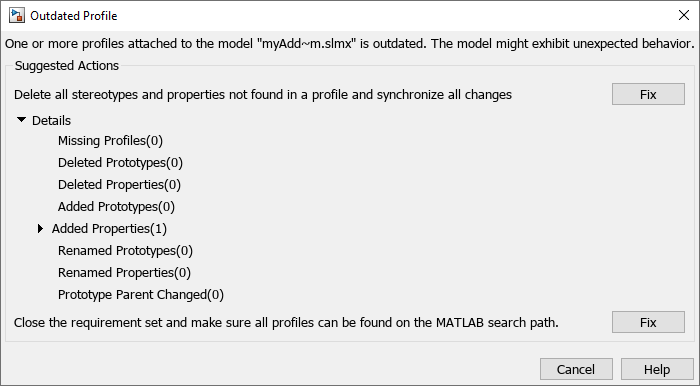
或者,您可以加载需求集并使用 slreq.load 并将 forceResolve 参量设置为 true 来修复过时的配置文件。
如果加载具有过时配置文件的链接集,则 MATLAB 命令行窗口将显示一条警告,提示分配给该链接集的配置文件已过时。要打开“过时的配置文件”对话框,请在需求编辑器中点击显示链接。选择链接集,然后在右侧窗格中的属性下点击详细信息。
注意
您无法使用 API 加载链接集并修复过时的配置文件。
删除原型或属性
如果您从配置文件中删除原型,并将配置文件更改应用于需求集或链接集,则对于使用该原型的需求或链接,Requirements Toolbox 会将需求类型恢复为 Functional,并将链接类型恢复为 Relate。
如果您从原型中删除原型属性并将配置文件更改应用于需求集或链接集,则 Requirements Toolbox 将从使用该原型的需求或链接中删除该属性和属性值。
管理和删除配置文件
要查看应用于需求集或链接集的配置文件,请在需求编辑器中选择需求集或链接集,然后点击管理。链接配置文件对话框显示分配给所选需求集或链接集的配置文件。
要从需求集或链接集中删除配置文件,请在“链接的配置文件”对话框中选择该配置文件,然后点击删除。如果您删除配置文件,Requirements Toolbox 会将这些更改应用于使用该配置文件的需求和链接:
将需求类型设置为
Functional将链接类型设置为
Relate删除原型属性并删除原型属性值
注意
如果您删除或重命名配置文件 XML 文件,Requirements Toolbox 也会应用这些更改。
根据内置配置文件创建原型
如果您拥有 Simulink® Fault Analyzer™ 许可证,您可以使用 mwAutomotive 内置配置文件模板指定汽车安全需求。要从此模板创建新的配置文件,请在需求编辑器的配置文件部分中点击加载 > mwAutomotive。
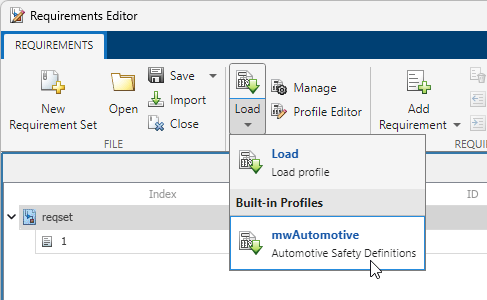
点击配置文件编辑器。该配置文件包含一个具有下面所示属性的原型。
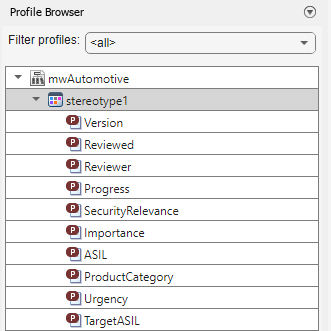
修改此原型的属性以满足您的设计规范。
另请参阅
主题
- Define and Style Stereotypes in Profiles (System Composer)
- 定义自定义需求和链接类型和属性
- 从 ReqIF 文件导入时使用原型